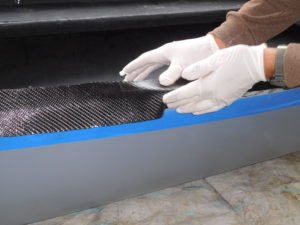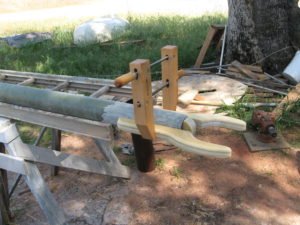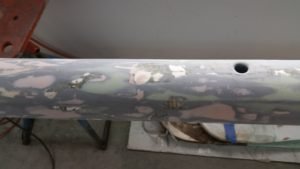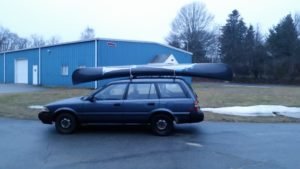And if I haven’t blogged all winter, it’s mostly because, unlike last winter when I had plenty of time to build dinghy molds and dinghies and re-do Ganymede’s cockpit, this winter I’ve done little of interest save for one or two side projects that I’ll get to in a bit. It’s not that I didn’t want to have a winter full of making interesting things—it’s just that having the opportunity to work full-time, indoors, in the slow winter months is not to be despised.
Of course the work was interesting enough—a 21’ Maine Cat folding catamaran needed a full refit, and I was given the keys to the shop and told to get started. I’ll spare the details; enough to say that the days I didn’t spend grinding fiberglass or contorting myself into tiny inisde corners were spent laminating glass, priming, or rolling Awlgrip. Again, not my first choice for a career, but it put food on the table with a little left over.

While I had access to the shop—the same shop where the winter before I’d built the new dinghy, bowsprit, and dinghy chocks—I decided to tackle another bit of Ganymede that hadn’t been addressed yet. While nearly every other part had been spruced up somehow, the boom was still in the orginal rough state we’d sailed in: not faired; leather getting ratty; and the gelcoat dinged off in places.

As the astute reader will remember, the boom was originally made by wrapping fiberglass around and around a length of ABS pipe, till it was about ½” thick all around, with fiberglass jaws permanently glassed on, and threads tapped in the glass for the fittings. It was ticklish, to say the least, getting it ashore in the dinghy, since it’s as much weight as I can stagger with, and it stuck out fore and aft pretty far without leaving much room to row.

Once the boom was safely transported to saw horses in the shop, with all the hardware gone, a belt sander and grinder made short work of the gelcoat and the bigger lumps I had carelessly left in its construction (remember that it was one of the last things I made, nearly three years into a lot of weary fiberglassing). In an effort to cut down on metal hardware I did what I’d done for Ganymede’s bowsprit, which was to glue fiberglass tubes through the section wherever hardware was to go. Through the center of the tubes can be put lashings, thus saving on weight and on fasteners.
While this was underway, I also effected a modification to the new dinghy chocks, which needed a cutout in the cambered surface so the new in-flange of the dinghy could sit flat. I confess I didn’t tackle either project with huge motivation: after a day of grinding and glassing on the Maine Cat, the last thing I wanted to do was sand and fair on the boom and chocks. Even so, due mostly to the smallness of the project, it was done in good time, the boom faired, primed, and Awlgripped; the chocks looking better than new.
After a few days in the basement for jaws leather and lashings, the boom was ready to return to Ganymede, and could be put aside to wait for better weather. In the meantime, a new project had come up: a carbon fiber canoe hull had failed to fully resin-infuse, and had some dry spots here and there in the laminate. I’m not really a canoe guy, but I’m a sucker for free stuff, and this was offered on the condition that I finish it nice-nice and get some use out of it.

It only took a Saturday morning to cut and grind out the dry carbon, prep it thoroughly, and lay up some new carbon for the repair. That got it to a state where I could take it home and pile it on top of all the other junk in my garage that’s waiting for better weather to process. When I have time—if I have time—I’ll finish the gunwales, add another layer of carbon to the inside, and then have more fairing and painting to do. It’s reassuring, in a way, to know that however much of it I do, there will always be just a little more painting to do to pass the time.


